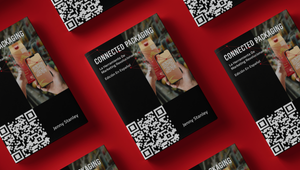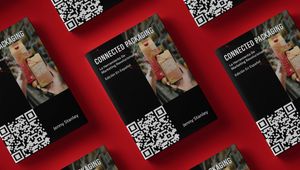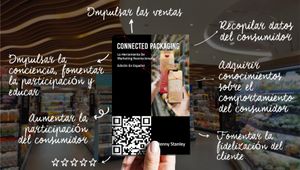
Revolutionising Sustainable Packaging: The Power of Connected Communication

Imagine having a direct line of communication with your customers, right at the moment they're holding your product. That's the magic of connected packaging. By incorporating QR codes or NFC tags onto your packaging, we're opening a world of possibilities for brands to engage, educate, and inspire their consumers.
But why is this so crucial, especially in the context of sustainability? The answer is simple: inclusion. As brands, we're constantly evolving, innovating and striving to be more sustainable. But if we don't bring our consumers along on this journey, we risk being misunderstood or, worse, accused of greenwashing.
Connected packaging bridges this gap. It allows us to tell our sustainability story, explain our innovations and guide consumers on how to properly use or recycle our products. It's not just about broadcasting a message; it's about creating a dialogue.

Education and Positioning: The Woodlands Dairy Success Story
One of our clients, Woodlands Dairy, wanted to position themselves as an environmentally conscious brand. We developed a quiz-based campaign accessed via QR codes on their packaging. Consumers could test their knowledge about sustainability, learn new facts, and even win prizes.
The results were astounding. We saw an average engagement time of over two minutes, with some users spending more than 10 minutes interacting with the content. But here's the kicker – during the campaign period, Woodlands Dairy saw a 30% increase in sales compared to the previous year. And remember, this was during a time of rising inflation and increased product costs. This campaign didn't just educate consumers; it drove tangible business results.

New Packaging Awareness: Elopak and Don Simon's Innovative Approach
When Elopak and Don Simon introduced a new, more sustainable carton that eliminated the aluminium layer, they faced a challenge: how to communicate this invisible innovation to consumers.
We created a multi-faceted digital experience accessed through QR codes on the packaging. Consumers can learn about the new packaging through interactive games, videos, and informative content. We incentivised engagement with a points system, allowing users to earn discounts or enter raffles.
This campaign not only raised awareness about the new packaging but also collected valuable consumer data, drove e-commerce sales, and encouraged product trial of new flavours.

Traceability: Building Trust Through Transparency
In an era where consumers are increasingly concerned about the origin and journey of their products, connected packaging offers an unparalleled opportunity for transparency.
We've developed solutions that allow consumers to trace their product from farm to shelf. By scanning a QR code, users can access information about the farmer, weather conditions during cultivation, packaging details, and even dispatch information. This level of transparency builds trust and reinforces a brand's commitment to sustainability and ethical practices.
Deposit Return Systems: Rewarding Sustainable Behaviours
Connected packaging isn't just about communication; it's also about action. We've implemented systems that facilitate and incentivise recycling and product returns.
By scanning a QR code, consumers can locate the nearest return centre, learn about proper recycling methods, and earn rewards for their sustainable actions. This not only encourages eco-friendly behaviours but also provides brands with valuable data on recycling rates and consumer engagement with sustainability initiatives.
The Power of Data
One of the most valuable aspects of connected packaging is the wealth of first-party data it provides. We can track who's scanning, when they're scanning, and where they're scanning. If users register, we can gather demographic information, allowing brands to tailor their messaging and offerings more effectively.
This data isn't just numbers on a screen; it's a window into consumer behaviour and preferences. It allows brands to refine their sustainability strategies, improve their products, and communicate more effectively with their target audience.
Looking to the Future
As we move forward, I see connected packaging becoming an integral part of every brand's sustainability strategy. It's not just about having a green message; it's about creating a green dialogue with your consumers.
The possibilities are endless. We could see packaging that changes its message based on real-time recycling rates in the local area, or packaging that connects with smart home devices to automate reordering of sustainable products.
The key is to view your packaging not as a static object, but as a dynamic platform for communication and engagement. It's your most direct touchpoint with your consumer – why not make it interactive, informative, and inspiring?
Connected packaging is more than just a passing tech trend; it's a fundamental shift in how brands can communicate their sustainability efforts. It's about education, transparency, and actionable engagement. It's about turning every product into an opportunity to reinforce your commitment to sustainability and bring your consumers along on that journey.
As we face the pressing challenges of climate change and resource scarcity, this technology offers a powerful tool to drive real change. By harnessing the power of connected packaging, we can create a more sustainable future – one scan at a time.















